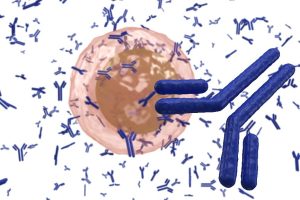The immune system in humans principally performs its defensive functions through two types of lymphocytes, namely T cells and B cells. T cells destroy or suppress directly, while B cells generate antibodies. Antibodies are vital immune response products produced by the human body to resist pathogen infection. Following vaccination or natural infection, human B cells become stimulated by antigens, leading them to proliferate and differentiate into plasma cells that generate antibodies. These antibodies, principally found in blood and other bodily fluids, can specifically bind to relevant antigens, defending the body in the process. Under normal conditions, if the body is invaded by bacteria or viruses, these microbes can generally be eliminated promptly through the action of antibodies.
Antibodies are basically proteins, or more specifically, globulins with immune function that exist in serum, bodily fluids, excretions, and on certain cell membranes, earning them the name immunoglobulins (Ig). Humans have at least five types of immunoglobulins, each one having distinct immunological functions: IgM, IgG, IgA, IgD, and IgE. Among these, IgG is the most common antibody and the main component of human serum immunoglobulins, accounting for 70% to 75% of the total quantity.

Immunoglobulins are secreted by B cells and are used by the immune system to identify and neutralize foreign matters such as bacteria and viruses. They are frequently found in human blood and on the cell membrane surface of B cells. These five types of immunoglobulins are incredibly vital for fighting off invading pathogens or other foreign antigens. The normal reference values for serum immunoglobulins are as follows: IgM 0.5-2.6g/L; IgG 7.0-16.6g/L; IgA 0.7-3.5g/L; IgD 0.01-0.04g/L; IgE 0.001-0.009g/L.
IgM, a pentamer, is the largest Ig molecule and also known as a huge globulin, with a half-life of 5-10 days. It cannot penetrate the vascular wall and is mainly present in blood and mucosal surfaces. It is the first effective antibody produced after vaccination or infection with a pathogen and is very significant in detecting early infections. Both natural anti-A and anti-B blood type agglutinins, rheumatoid factors, cold agglutinins, etc., belong to IgM antibodies. Increased IgM: Seen in early stages of viral, bacterial, parasitic infections, rheumatoid arthritis, scleroderma, and huge globulinemia. Decreased IgM: Seen in congenital and acquired immunodeficiency diseases, protein-losing diseases such as nephrotic syndrome, protein-losing enteropathy, large-area burns, etc.
IgG is the main component of serum immunoglobulin, accounting for 75% of total immunoglobulins. It is an antibody that appears later after pathogen infection and has the longest half-life of 23 days. It is the most lasting and vital antibody in the primary immune response and has the ability to fight against viruses, bacteria, and toxins. In clinical practice, passive immune-enhancing drugs such as injection of gamma globulin are mainly composed of IgG. When rescuing severe viral infection patients, injecting the convalescent plasma of patients who have had the disease can also bring about certain therapeutic effects. Increased IgG: Seen in various chronic infections like tuberculosis, leprosy, actinomycosis; chronic liver diseases like chronic viral active hepatitis, cryptogenic cirrhosis; connective tissue diseases like systemic lupus erythematosus, rheumatoid arthritis, scleroderma, Sjogren’s syndrome. Decreased IgG: Seen in various congenital and acquired gamma globulin deficiency diseases, heavy chain disease, light chain disease.
IgA is divided into serum type and secretory type. The serum type is a monomer, accounting for 5%-25% of the total serum immunoglobulin, and primarily exists in serum. The secretory type is a dimer, mainly distributed in the respiratory tract mucosa, digestive tract mucosa, and urinary tract mucosa, and is the main antibody participating in local mucosal immunity. It functions as the first line of body defense. Insufficient synthesis of secretory IgA may cause newborns to be prone to respiratory and digestive tract infections. Increased IgA: Seen in chronic infections, chronic liver diseases, multiple myeloma, systemic lupus erythematosus, rheumatoid arthritis, IgA nephropathy. Decreased IgA: Seen in congenital and acquired immunodeficiency diseases, protein-losing diseases, etc.
IgD is mainly produced by plasma cells in the tonsils, spleen, etc. It is a monomer molecule, accounting for 1% of total serum Ig, and its exact function in the serum is still unclear. Its main physiological function may be related to the prevention of immune tolerance and certain hypersensitivity reactions. B cells’ surface mIgD can serve as a marker for the differentiation and maturation of B cells. Increased IgD: Seen in IgD-type multiple myeloma, chronic osteomyelitis, epidemic hemorrhagic fever, cirrhosis, atopic diseases, Hashimoto’s thyroiditis, and viral infectious diseases. Decreased IgD: Seen in primary gamma globulinemia, pneumonia, and after cytotoxic drug treatment.
IgE, also known as reaginic, has an extremely low concentration in the serum and plays an important role in parasitic infections. It can bind to the FcεR on the surface of mast cells and basophils and primarily causes allergic reactions mediated by IgE. Increased IgE: Seen in allergic diseases like allergic rhinitis, exogenous asthma, atopic dermatitis, chronic urticaria; parasitic infections, IgE-type multiple myeloma, fungal infections. Decreased IgE: Seen in congenital or acquired gamma globulin deficiency, ataxia telangiectasia, immunosuppressive treatment, etc.
In summary, the five types of immunoglobulins play vital roles in both innate and adaptive immunity. They work in tandem to protect the body from a wide range of pathogens, reflecting the complexity and versatility of the human immune system. Any alterations in the levels of these immunoglobulins could imply potential immune deficiencies or overreactivity, leading to various health issues. Therefore, these proteins serve not only as pivotal components of the immune system but also as essential biomarkers for assessing immune status and diagnosing related diseases.

